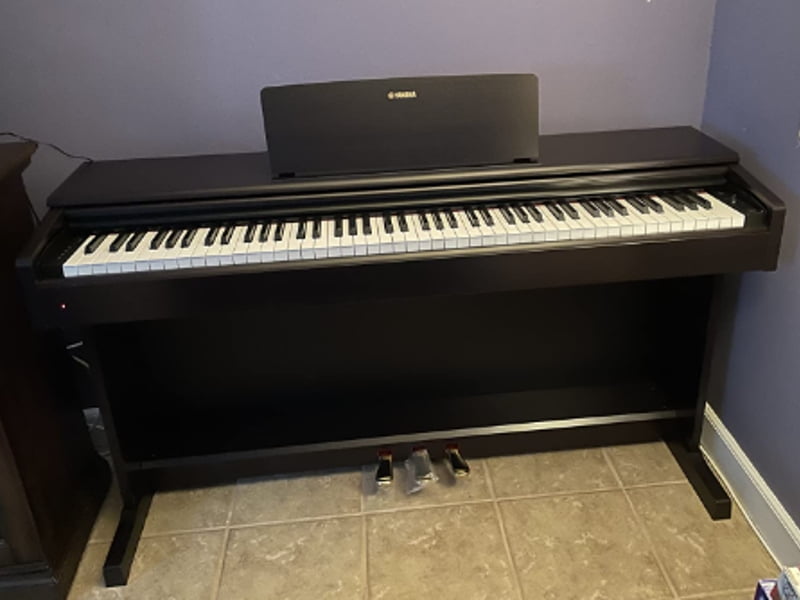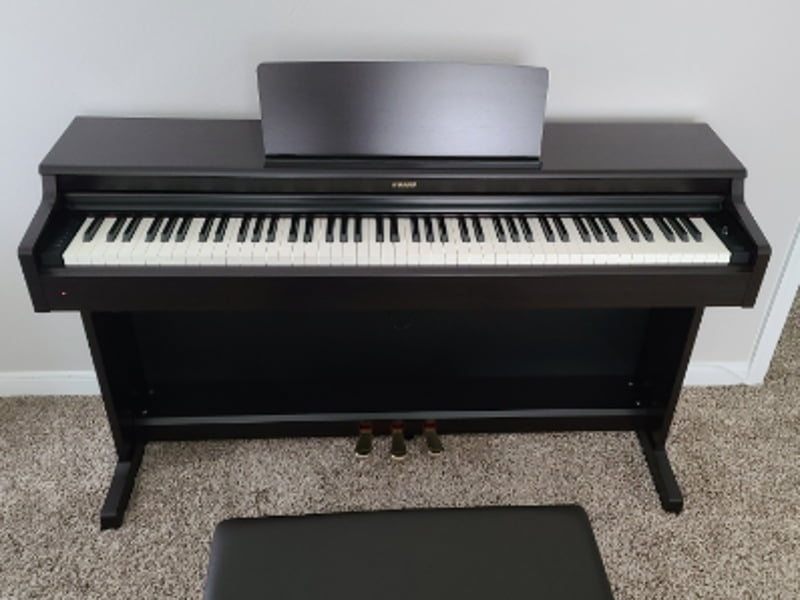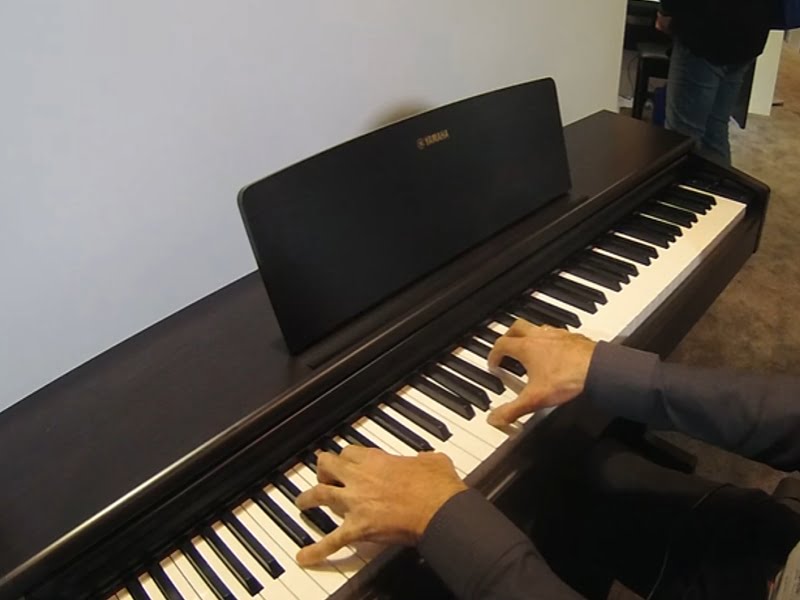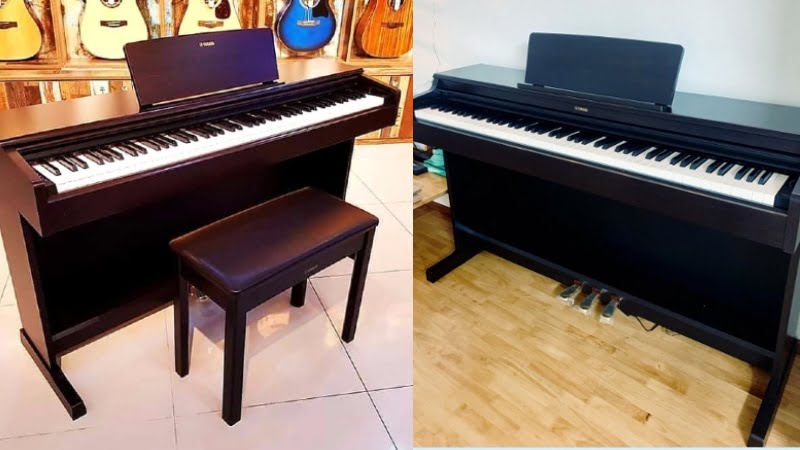The Yamaha Arius collection is full of great digital pianos. In this Yamaha YDP-144 vs 164 comparison, learn why the YDP-164 is a worthy upgrade and the better piano.
If you need a console digital piano, the Yamaha Arius collection has you covered. In my experience, these pianos offer the best value for the money in their price range. But since there are so many Arius models available, finding the best one might prove to be tricky.
In this Yamaha YDP-144 vs 164 comparisons, we’re looking at two very popular Arius models. These are some of the more-affordable Arius options, making this comparison very interesting.
After looking at all the features and trying the pianos out myself, I found that the YDP-164 is the better option. This is the more expensive piano, and it comes with many features that justify the price.
But even if I found the YDP-164 to be the better piano overall, the YDP-144 is still a great option, especially if you’re shopping on a tight budget.
Below, I’ll get into more details about both pianos so you can clearly see which features on the Yamaha YDP-164 are better than the YDP-144. And by the end, you’ll have a much easier time choosing between these two!
Yamaha YDP-144 vs 164: Comparison Chart




Last update on 2025-04-17 / Affiliate links / Images from Amazon Product Advertising API
Yamaha YDP-144 vs 164: A Head-to-Head Comparison
There were three main categories I used to compare these pianos. Whenever I get my hands on a digital piano, I look at the tone, feel, and polyphony. These are some of the most important qualities of any digital piano, and they’re the ones you must focus on the most when buying one of these instruments for yourself.
After comparing the two pianos based on these qualities, the score was 3-2 in favor of the YDP-164. The margins were very slim, but there was no doubt that the YDP-164 won. And in this section, I’ll detail how these pianos performed in each category to show you why the YDP-164 is the better option.
Tone
The winner: Tie
The first feature I look at whenever I get my hands on a digital piano is the tone. The only digital pianos that are worth your money are the ones that produce realistic tones. And with either of these pianos, you get rich and bright piano tones that sound really close to the real instrument.
Botht the Yamaha YDP-144 and 164 deliver great tones. In fact, they have the same tone engine and very similar sound libraries. So, if you’re particular about tone, both of these models will be great choices.

+Tone Generation
The reason the Yamaha YDP-144 and 164 come with great tones is the tone generator. These pianos utilize the CFX soung engine, which is one of the newest and most-advanced Yamaha tone engines available. This is one of the key upgrades that this batch of YDP pianos has over models like the YDP 143, 163, and more.
In the past, Yamaha YDP pianos used the Pure CF Sound Engine. This was a great tone generator, but the CFX engine is much better. That said, these sound engines work in a fairly similar manner.
To start, the CFX is a sample-based tone generator. So, both the YDP-144 and 164 come loaded with recordings of real Yamaha CF Grand Pianos. The CF line of grand pianos contains come of the most popular grand pianos on the market, so it’s great that Yamaha chose these samples for their pianos.
The reason CFX is a step above Pure CF is because of teh quality of the samples. You’ll notice instantly that the CFX’s samples are much better than any tone from the Pure CF Sound Engine, which is why I would recommend both the YDP-144 and 164 for any pianist in need of realistic piano tones.
In this price range, you can’t do much better than Yamaha CFX. So, rest assured that most other models in this range will have a hard time coming up with more realistic tones than what you can find on the Ymaha YDP-144 and the 164.
+Sound Library
The Yamaha YDP-144 and 164 are console digital pianos. These are large and bulky pianos designed to mimic the sound and feel of an acoustic piano. And because of this, neither option comes with a rich and varied sound library. Instead, they both come with the essential tones that every pianist would need.
The Yamaha YDP-144 and 164 have the exact same tone library. You can choose between 10 different voices on this piano. On top of a few acoustic piano voices, these instruments also come with organ, strings, electric piano, and bass voices.
While this isn’t the most varied set of sounds, it’s all you will need as a pianist. There are many pianos on the market that come with hundreds of unique voices. But if you don’t need these voices or have no plans on using them in your music, it isn’t worth investing in these models.
The sound library on the Yamaha YDP-144 and 164 are ideal for pianists that only need the basic sounds. And since these pianos use the Yamaha CFX, you can expect that each and every tone is top-tier, which is another reason why I consider these to be some of the best Yamaha pianos on the market.

Feel
The winner: Yamaha YDP-164
The biggest and one of the only differences between the YDP-164 and the YDP-144 is the hammer action system. It’s very important to get a digital piano that replicates the feel of an acoustic piano, and both the YDP-164 and the YDP-144 do that.
However, the YDP-164, as the more expensive option, comes with a more advanced hammer action system. Because of this, it feels more realistic than the YDP-144 and takes the point for this category.
+Hammer Action
When I compared the hammer action of these two pianos, the Yamaha YDP-164 was slightly better. However, the difference was very minimal and you’d only really notice it if you’re an experienced pianist. If you’re a beginner, these hammer action systems might feel identical to you.
The Yamaha YDP-144 uses the Graded Hammer Standard or GHS action. This is a great Yamaha system that you’ll find on many of their models. The primary feature of this hammer action system is that the weight is graded. So, the bass keys are heavier than the treble keys, just like with an acoustic piano.
The YDP-164, on the other hand, uses the GH3 hammer action. This is a clear upgrade on the GHS action because aside from having the graded weight, this system also has a faster spring back. When you play a premium acoustic piano, the keys spring back in a very specific way, which is one of the key features of a premium acoustic piano.
The YDP-164 does a better job at replicating the feel of a premium acoustic piano, which is why it wins the point in the feel comparison. Again, if you’re a beginner, you won’t really feel the difference, which is very minimal.
Polyphony
The winner: Tie
The last feature I comparead was the polyphony. This is basically the piano’s ability to play multiple notes simultaneously. Nowadays, it’s best to get a piano with high polyphony as it gives you more versatility and results in clearer piano tones.
Luckily, both models come with 192-note polyphony. This is great, as you don’t have to worry about the piano not being able to sustain notes when you’re stacking them on top of each toher. This also gives you a lot more versatility when using the various playing modes on these pianos such as dual and split mode.
Since both pianos had the same polyphony, I couldn’t give the point to just one piano. Instead, I awarded a point to both models, since they clearly deserve it.

Yamaha YDP-144 vs 164: The Similarities
These pianos share many similarities. In fact, they are almost identical except for the hammer action system on the YDP-164. So, when it comes to tone, piano features, versatility, and even design, you can expect the same thing from both pianos.
This is great, since the YDP-164 and 144 offer great tones and have a straightforward design, making them great picks for anyone in need of a home piano.
That said, while they share the same upside, they also share a few drawbacks. As console digital pianos, these instruments aren’t the msot versatile options available, so if you’re looking for a piano to bring with you to gigs, these may not be the best picks for you.
These piano are designed to stay in one place. You’ll have to forgo some flexibility, but in return you get a more realistic looking and feeling digital piano!
Quick Rundown of the Yamaha YDP-144
- Your purchase includes One Yamaha Arius Series, YDP144 model | Bench, 50 Classical Music Masterpieces Book, Owner’s manual & Quick Operation Guide
- Piano dimensions – 53-7/16” W x 32-1/16” H x 16-5/8” | Weight – 83 lbs. | Number of pedals – 3 | Max polyphony – 192 | Number of voices – 10 | Headphones – (2) Standard Stereo phone jack | With Recording and Playback capabilities
- GHS weighted action is heavier in the low keys and lighter in the high keys, just like an acoustic piano
- Half-damper pedal control allows for continuously increasing amounts of sustain as the pedal is depressed
- The CFX Premium Grand Piano Voice recreates the power and tone of the flagship CFX concert grand piano from Yamaha
Last update on 2025-04-17 / Affiliate links / Images from Amazon Product Advertising API
Quick Rundown of the Yamaha YDP-164
- Your purchase includes One Yamaha Arius Series, YDP164 model | Bench, 50 Classical Music Masterpieces Book, Owner’s manual & Quick Operation Guide
- Piano dimensions – 53-7/16” W x 33-27/64” H x 16-5/8” | Weight – 92 lbs. | Number of pedals – 3 | Max polyphony – 192 | Number of voices – 10 | Headphones – (2) Standard Stereo phone jack | With Recording and Playback capabilities
- GHS weighted action is heavier in the low keys and lighter in the high keys, just like an acoustic piano
- Half-damper pedal control allows for continuously increasing amounts of sustain as the pedal is depressed
- The CFX Premium Grand Piano Voice recreates the power and tone of the flagship CFX concert grand piano from Yamaha
Last update on 2025-04-17 / Affiliate links / Images from Amazon Product Advertising API
Product Video
Related Articles to Yamaha Ydp 144
- Yamaha YDP144 vs YDP-144R: What’s the Difference?
- Yamaha YDP-144 vs YDP-S54: What’s the Difference?
- Yamaha YDP-144 vs 184: Which Is the Best Arius Model for the Money?
- Yamaha YDP-144 vs YDP-181: Is the YDP-144 a Worthy Upgrade?
- Yamaha YDP-144 vs Roland F-140R: Which Digital Piano Do You Need?
- Yamaha YDP-144 vs Kawai KDP-120: Which Piano Is the Best?
- Yamaha YDP-144 vs Kawai KDP-110: Why the YDP-144 Is the Better Piano
- Yamaha DGX-660 vs YDP-144: Which Is the Better Yamaha Piano?
- Yamaha DGX-670 vs YDP 144: Finding the Best Digital Piano
- Yamaha YDP144 vs 163: Which Is The Best Arius?
- Yamaha YDP144 vs S34: Which Suits Your Style Better?
- Yamaha YDP-143 Vs 144: Is The YDP-144 A Worthy Upgrade?
- Yamaha YDP-103 Vs 144: A Battle Of Two Arius Models
- Casio PX-870 Vs Yamaha YDP-144: Which Is The Better Console Digital Piano?
- Casio PX-770 vs Yamaha YDP-144: Which Is The Better Digital Piano?
Related Articles to Yamaha Ydp 164
- Yamaha YDP-164 vs DGX-660: Why You Should Go for the DGX-660
- Yamaha P125 Vs YDP 164: Should You Get A Console Or Digital Piano?
- Casio PX-870 Vs Yamaha YDP-164: Which Is The Better Choice For Beginners?
References:
- Yamaha YDP-144: https://usa.yamaha.com/products/musical_instruments/pianos/arius/ydp-144/specs.html#product-tabs
- Yamaha YDP-164: https://usa.yamaha.com/products/musical_instruments/pianos/arius/ydp-164/specs.html#product-tabs
Lulacruza is an electronic folk duo operating at the junction of the hypermodern and the ancient. Our music weaves together hypnotic female singing, South American folk instruments and electronic processing, while channeling pulsating waves from the source of creation.
Lalucruza is also a community where you can connect with other music lovers to collaborate, exchange ideas and share knowledge. A platform for who wants to learns the basics of playing piano, guitar, drum masters’ technique, etc.. is the premise of our website.
